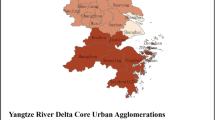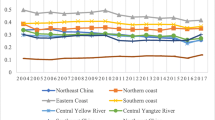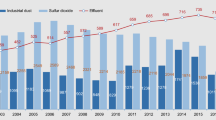Abstract
China is the most populous country in the world, and the pollution caused by the excessive population should not be underestimated. In recent years, China’s population growth rate began to decline. Since 2003, the growth rate has dropped below 6‰, but the population base is still huge. This paper aims to study the influence of population structure on pollutant discharge. Using the improved STIRPAT model, we studied the panel data of 31 provinces from 2003 to 2017 to study the impact of population on pollutant discharge from the perspectives of gender, aging and urbanization. The results show that population affects pollutant discharge through three effects, among which gender effect and urbanization effect increase pollutant discharge, and gender effect has a greater impact on pollutant discharge than urbanization effect. But the aging effect helps to reduce pollutant discharge during the study period. The results also show that population size contributes to pollutant discharge in the east, west, and northeast. However, population size had no significant effect on pollutant discharge in the middle part. Therefore, it is necessary to consider the difference of population impact when making environmental policy effectively. Finally, some special issues are briefly discussed.







Similar content being viewed by others
References
Al-Mulali U, Ozturk I, Lean HH (2015) The influence of economic growth, urbanization, trade openness, financial development, and renewable energy on pollution in Europe. Nat Hazards 79:621–644
Cao L, Zhou Z, Wu Y, Huang Y, Cao G (2019) Is metabolism in all regions of China performing well? – Evidence from a new DEA-Malmquist productivity approach. Ecol Indic 106:105487
Cao L, Li L, Wu Y, Zeng W (2020) Does industrial convergence promote regional metabolism? Evidence from China. J Clean Prod:123010
Charnes A, Cooper WW, Lewin AY, Morey RC, Rousseau J (1984) Sensitivity and stability analysis in DEA. Ann Oper Res 2:139–156
Chen Y, Jin GZ, Kumar N, Shi G (2013) The promise of Beijing: evaluating the impact of the 2008 Olympic Games on air quality. J Environ Econ Manag 66:424–443
Chen J, Wang B, Huang S, Song M (2020) The influence of increased population density in China on air pollution. Sci Total Environ 735:139456
Chertow MR (2000) The IPAT equation and its variants. J Ind Ecol 4:13–29
Cole MA, Neumayer E (2004) Examining the impact of demographic factors on air pollution. Popul Environ 26:5–21
Commoner, B., 1990. Making peace with the planet.
Cooper, W.W., 2001. Data envelopment analysis (DEA)Data envelopment analysis.
Cui P, Xia S, Hao L (2019) Do different sizes of urban population matter differently to CO2 emission in different regions? Evidence from electricity consumption behavior of urban residents in China. J Clean Prod 240:118207
Dalton M, O’Neill B, Prskawetz A, Jiang L, Pitkin J (2008) Population aging and future carbon emissions in the United States. Energ Econ 30:642–675
Du J, Pan M, Chen Y, Duan Y (2020) An efficiency-based allocation of carbon emissions allowance: a case study in China. J Clean Prod 251:119346
Ehrlich PR, Holdren JP (1971) Impact of population growth. Science 171:1212–1217
Fan Y, Liu L, Wu G, Wei Y (2006) Analyzing impact factors of CO2 emissions using the STIRPAT model. Environ Impact Asses 26:377–395
Fang C, Liu H, Li G, Sun D, Miao Z (2015) Estimating the impact of urbanization on air quality in china using spatial regression models. Sustainability-Basel 7:15570–15592
Feng K, Hubacek K, Guan D (2009) Lifestyles, technology and CO_2 emissions in China: a regional comparative analysis. Ecol Econ 69:145–154
Huang Q, Zheng X, Liu F, Hu Y, Zuo Y (2018) Dynamic analysis method to open the “black box” of urban metabolism. Resour Conserv Recycl 139:377–386
Jorgenson AK, Clark B (2010) Assessing the temporal stability of the population/environment relationship in comparative perspective: a cross-national panel study of carbon dioxide emissions, 1960-2005. Popul Environ 32:27–41
Kwon TH (2005) Decomposition of factors determining the trend of CO2 emissions from car travel in Great Britain (1970–2000). Ecol Econ 53:261–275
Li K, Fang L, He L (2019) How population and energy price affect China’s environmental pollution? Energ Policy 129:386–396
Li H, Lu J, Li B (2020) Does pollution-intensive industrial agglomeration increase residents’ health expenditure? Sustain Cities Soc 56:102092
Liddle B (2011) Consumption-driven environmental impact and age structure change in OECD countries: a cointegration-STIRPAT analysis. Demogr Res 24:749–770
Liddle B (2014) Impact of population, age structure, and urbanization on carbon emissions/energy consumption: evidence from macro-level, cross-country analyses. Popul Environ 35:286–304
Liddle B (2015) What are the carbon emissions elasticities for income and population? Bridging STIRPAT and EKC via robust heterogeneous panel estimates. Glob Environ Chang 31:62–73
Liu K, Lin B (2019) Research on influencing factors of environmental pollution in China: a spatial econometric analysis. J Clean Prod 206:356–364
Liu WB, Zhang DQ, Meng W, Li XX, Xu F (2011) A study of DEA models without explicit inputs. Omega 39:472–480
Liu W, Zhou Z, Ma C, Liu D, Shen W (2015) Two-stage DEA models with undesirable input-intermediate-outputs. Omega 56:74–87
Martínez-Zarzoso I, Maruotti A (2011) The impact of urbanization on CO2 emissions: evidence from developing countries. Ecol Econ 70:1344–1353
Nakamura H, Kato T (2011) Climate change mitigation in developing countries through interregional collaboration by local governments: Japanese citizens’ preference. Energ Policy 39:4337–4348
O’Neill BC, Liddle B, Jiang L, Smith KR, Pachauri S, Dalton M, Fuchs R (2012) Family planning 3: demographic change and carbon dioxide emissions. Lancet (British edition) 380:157
Poumanyvong P, Kaneko S (2010) Does urbanization lead to less energy use and lower CO2 emissions? A cross-country analysis. Ecol Econ 70:434–444
Sadorsky P (2014) The effect of urbanization on CO2 emissions in emerging economies. Energ Econ 41:147–153
Seiford LM, Thrall RM (1990) Recent developments in DEA: the mathematical programming approach to frontier analysis. J Econ 46:7–38
Shanzi K (2009) Spread-backwash and market area effects of urban and regional growth in China. Econ Res:85–98
Shi AQ (2003) The impact of population pressure on global carbon dioxide emissions, 1975-1996: evidence from pooled cross-country data. Ecol Econ 44:29–42
Sun C, Luo Y, Li J (2018) Urban traffic infrastructure investment and air pollution: evidence from the 83 cities in China. J Clean Prod 172:488–496
Thomas D, Eugene A, Rosa (1994) Rethinking the environmental impacts of population, affluence and technology. Hum Ecol Rev 1:277–300
Wang Y, Zhao H, Li L, Liu Z, Liang S (2013) Carbon dioxide emission drivers for a typical metropolis using input–output structural decomposition analysis. Energ Policy 58:312–318
Wang S, Fang C, Guan X, Pang B, Ma H (2014) Urbanisation, energy consumption, and carbon dioxide emissions in China: a panel data analysis of China’s provinces. Appl Energy 136:738–749
Wang Y, Kang Y, Wang J, Xu L (2017) Panel estimation for the impacts of population-related factors on CO2 emissions: a regional analysis in China. Ecol Indic 78:322–330
Xie R, Fang J, Liu C (2017) The effects of transportation infrastructure on urban carbon emissions. Appl Energy 196:199–207
Xu B, Lin B (2015) How industrialization and urbanization process impacts on CO2 emissions in China: evidence from nonparametric additive regression models. Energ Econ 48:188–202
Yang M, Ma T, Sun C (2018) Evaluating the impact of urban traffic investment on SO2 emissions in China cities. Energ Policy 113:20–27
Yeh J, Liao C (2017) Impact of population and economic growth on carbon emissions in Taiwan using an analytic tool STIRPAT. Sustain Environ Res 27:41–48
Yu Y, Deng Y, Chen F (2018) Impact of population aging and industrial structure on CO 2 emissions and emissions trend prediction in China. Atmos Pollut Res 9:446–454
Zhang C, Tan Z (2016) The relationships between population factors and China’s carbon emissions: does population aging matter? Renew Sust Energ Rev 65:1018–1025
Zhang N, Yu K, Chen Z (2017) How does urbanization affect carbon dioxide emissions? A cross-country panel data analysis. Energ Policy 107:678–687
Zhao H, Liu Y, Lindley S, Meng F, Niu M (2020) Change, mechanism, and response of pollutant discharge pattern resulting from manufacturing industrial transfer: a case study of the Pan-Yangtze River Delta, China. J Clean Prod 244
Zhou Y, Liu Y (2016) Does population have a larger impact on carbon dioxide emissions than income? Evidence from a cross-regional panel analysis in China. Appl Energy 180:800–809
Zhou C, Wang S (2018) Examining the determinants and the spatial nexus of city-level CO2 emissions in China: a dynamic spatial panel analysis of China’s cities. J Clean Prod 171:917–926
Zhou Z, Xiao H, Jin Q, Liu W (2018) DEA frontier improvement and portfolio rebalancing: an application of China mutual funds on considering sustainability information disclosure. Eur J Oper Res 269:111–131
Funding
This research is supported by the National Social Science Foundation of China (Nos.17ZDA081) and Hunan Provincial Social Science Foundation of China (No.18ZWA20).
Author information
Authors and Affiliations
Corresponding author
Additional information
Responsible Editor: Philippe Garrigues
Publisher’s note
Springer Nature remains neutral with regard to jurisdictional claims in published maps and institutional affiliations.
Appendix
Appendix
Rights and permissions
About this article
Cite this article
Cao, L., Li, L. & Wu, Y. How does population structure affect pollutant discharge in China? Evidence from an improved STIRPAT model. Environ Sci Pollut Res 28, 2765–2778 (2021). https://doi.org/10.1007/s11356-020-10589-3
Received:
Accepted:
Published:
Issue Date:
DOI: https://doi.org/10.1007/s11356-020-10589-3




